Eric C. Sheninger's Blog, page 14
August 21, 2022
Addressing SEL and Behavior Challenges with Relationships
One question that is posed to me often by districts and schools is how their staff can be proactive when it comes to student behavior and addressing their social-emotional needs. It comes as no surprise to anyone that the pandemic, in the eyes of many, has led to an uptick in issues that not only disrupts precious learning time but also results in more discipline referrals, tardies, and absences. There is no silver bullet as many behavioral challenges manifest themselves outside the school day. However, practical mitigation steps can be taken by doing what we all know is of utmost importance to learning and that is developing relationships, something a dive into great detail in Disruptive Thinking in Our Classrooms.
So, where do we begin? It is essential to realize how vital social-emotional learning (SEL) is when it comes to student behavior and academic success. A meta-analysis of 213 school-based, universal social and emotional learning (SEL) programs involving 270,034 kindergarten through high school students showed promising results. Compared to controls, SEL participants demonstrated significantly improved social and emotional skills, attitudes, behavior, and academic performance that reflected an 11-percentile-point gain in achievement (Durlak et al., 2011).
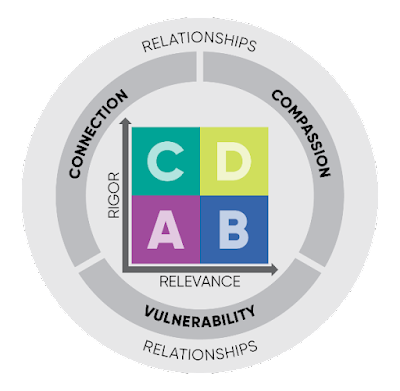
At the International Center for Leadership in Education (ICLE), we developed a relationships model in partnership with Dr. Stephanie Jones at the Harvard EASEL Lab that we utilize with administrators and teachers to create vibrant learning cultures. As this model shows, the impact of rigorous and relevant teaching and learning relies on strong student-educator relationships. The way to shape these relationships is through purposeful behaviors tied to three key indicators: Connection, Compassion, and Vulnerability. When you reflect on this above, consider what current practices support the main elements listed. In a past post, I outlined some specific SEL strategies that can be used at any time to aid in the process of addressing SEL needs and behavior, including daily meeting, digital surveys, and family engagement.
While there is a wealth of resources out there, I would be remiss if I didn’t outline some practices that can be employed regularly. For each, I attempt to highlight the clear benefits.
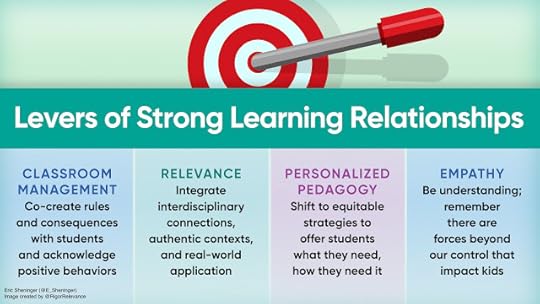
Classroom Management: Co-create rules and consequences with students. Acknowledge positive behaviors regularly. Admin should look to work daily meetings into the schedule as a way to help teachers with management issues. Relevance: There is a great deal of research out there on the importance of relevance in the classroom and school, which you can read HERE. Students want purpose in their learning. Integrate interdisciplinary connections, authentic contexts, and real-world applications regularly to help convey meaning.Personalized Pedagogy: Moving away from a one-size-fits-all approach to equitable strategies can seamlessly align with RTI/MTSS, which are designed to address behavior proactively. Consider station rotation, choice activities, playlists, and flipped lessons to free up time to work with students who really need in-class support. Empathy: Using an empathetic lens by placing yourself in your students' shoes can help reduce kneejerk reactions. It is always important to remember that forces beyond our control impact kids.
Additionally, two of my ICLE colleagues had some incredible content for districts, schools, and educators to leverage immediately. Adam Drummond shared a comprehensive article on developing relationships by leading through compassion, embracing vulnerability, and making connections. You will not only find applicable relationship-building strategies here but also an array of visuals to focus on areas of growth. Venola Mason explains that supporting students’ social and emotional wellness is a catalyst for building strong teacher-student relationships that can ensure they are better adjusted, have more confidence, and perform better academically. In a recent article, she details five tips to assist with this process:
Be personable with studentsGet to know studentsSet stretch goalsMake learning funReach out to students in needWithout trust, there is no relationship. Without relationships, no real learning occurs.
Durlak, J.A., Weissberg, R.P., Dymnicki, A.B., Taylor, R.D. and Schellinger, K.B. (2011), The Impact of Enhancing Students’ Social and Emotional Learning: A Meta-Analysis of School-Based Universal Interventions. Child Development, 82: 405-432.
August 14, 2022
Boost Morale with These Simple Strategies
Morale can best be defined as the confidence, enthusiasm, and discipline of a person or group at a particular time. Thriving cultures that produce results make every effort to keep this on the positive side. However, this is easier said than done. While the pandemic has undoubtedly played a monumental role in decreasing morale, other factors continuously play a role, such as leadership, mandates, lack of time, systems that are in place, a toxic culture, inadequate pay, or trying to maintain a work-life balance. No matter the cause, it’s up to the leader and their team to constantly be proactive to combat low morale.
Below are some simple strategies that you can use immediately and long-term, many of which are research-based.
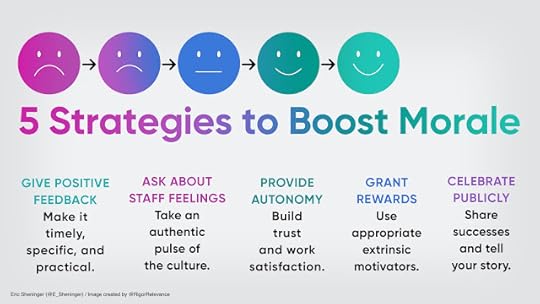
Pile on the positive feedback
Sometimes there is never enough of a good thing when it comes to building up culture. Research has shown that feedback is vital in establishing good relations as it can enhance relationships, strengthen loyalty and commitment, and increase morale (Smith, 2009). When it comes to feedback, make sure it is timely, specific, practical, facilitated in a positive manner, and is a dialogue as opposed to a monologue. Actively look for opportunities to provide feedback through diverse means such as phone calls, paper notes, technology, and face-to-face conversations.
Actively inquire about how people are feeling
While this might seem like a no-brainer, it is not easy at times to know how people really feel unless diligent efforts are made to find out. Listening is one of the best tools that can be leveraged to gather crucial information on the pulse of a culture. Creating a roundtable for staff to share what is on their mind is another solid option, but digital forms that allow anonymous responses could very well be the best route.
Provide autonomy
Micro-managing never ends well. Using self-determination theory (Deci & Ryan, 2008), a study involving 735 workers was conducted to examine autonomy's impact on overall morale. Results revealed that work motivation was significantly related to both intraindividual (global motivation) and contextual factors (organizational support and supervisor autonomy support). It can be concluded that perceived organizational support and work autonomous motivation was positively related to work satisfaction (Gillet et al., 2013). As a principal, I created the Professional Growth Period (PGP) to grant unconditional autonomy to my staff.
Gift appropriate rewards
The key word above is appropriate. While I am a massive proponent of intrinsic means to improve motivation, that does not mean we cannot leverage extrinsic rewards as a means to boost morale. Examples include release time, professional learning opportunities off-site, a premium parking spot, tickets to school events, books, and school supplies. If you really want to boost morale, try eliminating as many after-school meetings as possible. The bottom line is that people want to be recognized, but morale will be most positively impacted by using authentic rewards that your staff value and do not see as disingenuous (White, 2014).
Celebrate publicly
It is hard to argue the fact that people want to have some semblance of fun and feel appreciated. A study using a large email survey of managers found overwhelming support for having fun in the workplace. Respondents reported that having a fun work environment will increase the levels of enthusiasm, satisfaction, creativity, communications among staff and enhanced feelings of group cohesiveness (Ford et al., 2004). Some schools have large-scale team-building events both on and off-site. If you go this route, elicit feedback from staff on what options they think will be best. You can also share stories across social media as a way to share successes more broadly, something I dive into deeply in Digital Leadership.
Sustaining and improving outcomes relies on good morale. It also plays a pivotal role in retaining our most precious people…those who commit themselves to serve kids.
Deci, E. & Ryan, R. (1994) Promoting Self‐determined Education, Scandinavian Journal of Educational Research, 38:1, 3-14.
Ford, R.C., Newstrom, J.W. and McLaughlin, F.S. (2004), "Making workplace fun more functional", Industrial and Commercial Training, Vol. 36 No. 3, pp. 117-120.
Gillet, N., Gagné, M., Sauvagère, S. & Fouquereau, E. (2013) The role of supervisor autonomy support, organizational support, and autonomous and controlled motivation in predicting employees' satisfaction and turnover intentions, European Journal of Work and Organizational Psychology, 22:4, 450-460.
Smith, D. C. (2008). Teaching Managers To Relate: Using Feedback To Bolster Commitment And Morale. Journal of Diversity Management (JDM), 3(3), 7–12.
White, P. (2014), "Improving staff morale through authentic appreciation", Development and Learning in Organizations, Vol. 28 No. 5, pp. 17-20.
August 7, 2022
Identifying the Best Supports for Personalization
We know for a fact that everyone learns differently. While a one-size-fits-all approach served its purpose for some of us, it doesn’t meet the diverse needs of kids today. It also doesn’t provide teachers and administrators with valuable insight on how to best support learners no matter where they are in relation to standards and critical competencies. Thus, educators need not only a vision for how to personalize learning effectively but also essential supports that will help to ensure success.
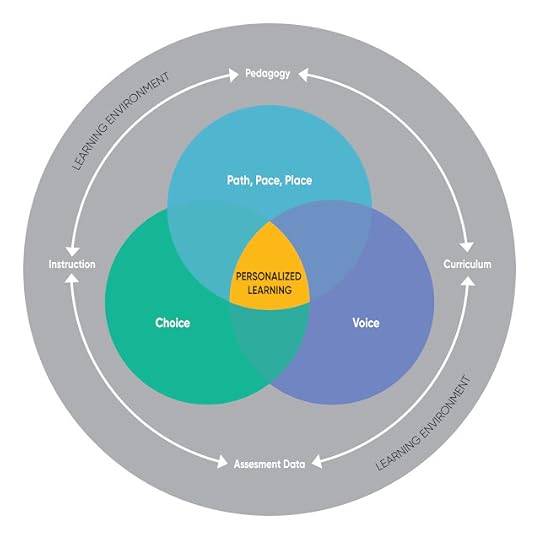
The most crucial aspect when it comes to personalizing learning is the teacher in the classroom. While mindset and relationship building work to form the foundation for a more personal approach, leveraging sound pedagogical practice to assist all students in getting what they need when and where they need it ensures equity in the classroom. In chapter 5 of Disruptive Thinking in Our Classrooms, I dive deeply into these practices while providing numerous examples. You can read a summary of the most used strategies with a high degree of fidelity HERE.
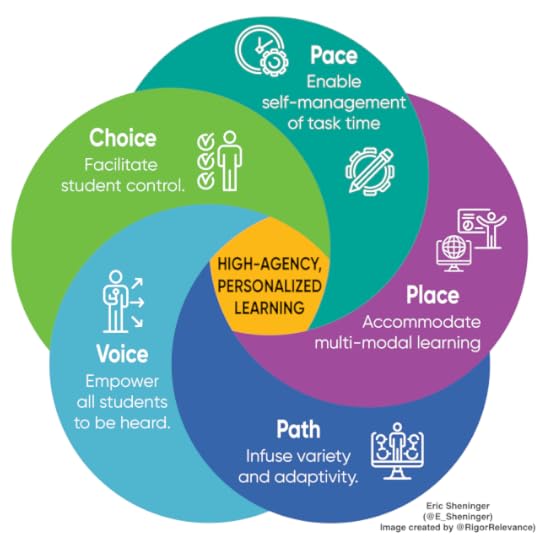
Personalized pedagogy sets the stage for the purposeful use of technology to better assist in meeting students' learning needs while providing educators with timely data. While there are many K-8 tools on the market, many have shortcomings such as no research base, difficulty in pulling useable data, no clear alignment to standardized tests, and students finding the tasks to be boring. Naturally, this can be quite frustrating when large sums of money are spent on purchasing these programs. Don’t fret, though, as a fantastic support option is available to districts and schools in the form of Waggle.
Waggle is a tool that K-8 educators can use to support the successful implementation of a more personalized approach. While you can learn more here, below are some specific highlights and features that set it apart from tools such as i-Ready and IXL.
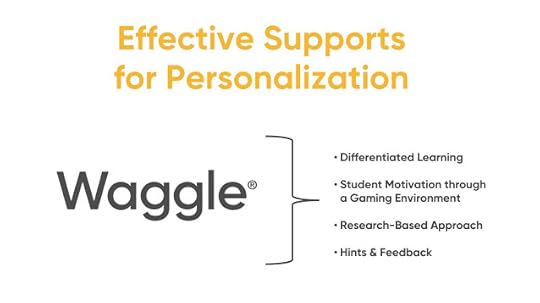
Differentiated Learning
A hallmark of personalization, Waggle provides:
Auto-assigned appropriate practice and instruction, or teachers can play an active role and assign additional content that supports their core instruction.Teacher access to K-8 content. Adaptive functionality that analyzes beyond proficiency. Based on 13 data points, it continuously adjusts to offer true personalization, including behavior and prerequisite knowledge.Instruction and practice on prerequisite skills within the grade level and from earlier grade levels.Student Motivation through a Gaming Environment
Students can:
Learn in an immersive, game-based environment. Access a dashboard that allows them to track their own progress toward mastery of skills and learning.Choose age-appropriate worlds to visit.Personalize their avatar.Research-Based
Waggle leverages research-based techniques to enhance students’ knowledge and accelerate learning. Waggle provides Retrieval, Interleaving and Spaced-Out Practice and Feedback, which yield long-term retention and optimal performance.
Retrieval is the act of recalling what has been learned and is essential for creating long-lasting memories. Retrieval best enhances retention when practiced early and often in a low-pressure context. Interleaving involves switching up the types of problems students solve when practicing. Changing the order or type of activity increases the effort and may create more cues for memory. Waggle Practice is comprised of multiple related skills. A student must have mastery of all these skills and be able to apply them simultaneously to be successful. Spaced Out Retrieval across multiple shorter sessions, days, or weeks is more effective than one long session for long-term retention because it requires more effortful processing.Hints & Feedback
Feedback is information provided to learners about their current level of knowledge and what they can do to progress to the next level. It is an essential step in making formative assessment as meaningful as it does in Waggle. Feedback only works if it is received and acted on by the learner, so both the content and the delivery of feedback matter. Waggle has robust hints embedded in every practice assignment and immediate feedback for every learning activity. Waggle provides a safe, supportive environment through scaffolded hints, support for English learners, explanatory feedback, and optional instructional lessons. Mistakes are embraced as learning opportunities.
The premise of personalization is all learners getting what they need when and where they need it to learn. When utilizing a pedagogy first, technology second lens, Waggle can become your tool of choice to improve student outcomes aligned with job-embedded and ongoing professional learning facilitated by the International Center for Leadership in Education (ICLE).
July 31, 2022
Learner Paths are Rarely the Same
At times I find myself claiming that I am a visual learner. Hence, I try to have an original image to go along with most blog posts I write. While text adds needed details and depth, the accompanying visuals provide more context. They also do a great job capturing the attention of prospective readers. I am not alone in my affinity for pictures. Researchers at MIT found that the brain can process images as quickly as 13 milliseconds. Now that is fast!
While my preference as a learner might be through visuals, I know there are other pathways as well. Herein lies the foundational tenant of personalized learning, something I shared in Disruptive Thinking in Our Classrooms:
Personalization is ALL kids getting what they need when and where they need it to learn.
I have written extensively on the many ways to personalize learning, but like most things, there are always different lenses and strategies that can be used. During my coaching work with educators, I always try to make the concept as simple as possible by showing the unique pathways to help kids learn. Enter the Rigor Relevance Framework. The premise is as simple as it is powerful. Learning occurs when students are challenged to think and apply their thinking in relevant ways.
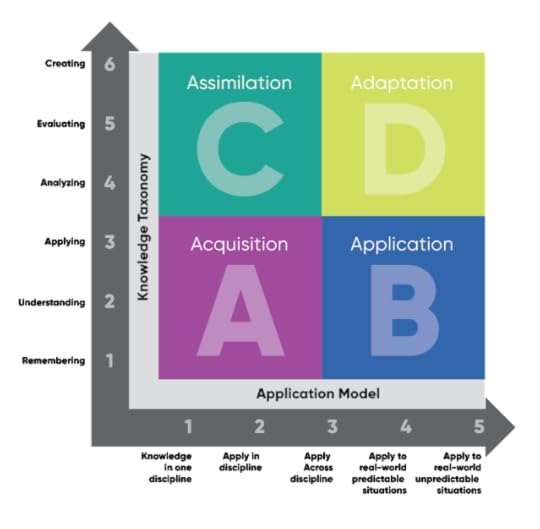
This framework is a tool to examine curriculum, instruction, and assessment along the two dimensions of increasing cognition and student outcomes. It can be used in the development of personalized pedagogical techniques in alignment with virtually any strategy. In addition, teachers can use it to monitor their own progress in adding rigor and relevance while selecting appropriate strategies for differentiation and facilitation of learning goals. In a previous post, I discussed getting kids into the learning pit, which moves them naturally through the various quad but in no specific order. The movement is dictated by where they currently are and how they eventually get to where they need to be, a hallmark of personalization.
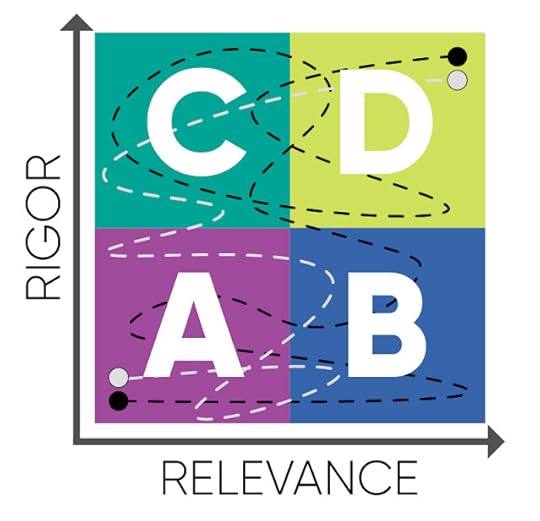
The journey to quad D is never linear. It will also look different for every learner, so don’t get fixated on where I put the dots on the image above. Another critical aspect is that you don’t need technology to personalize. Authenticity, deeper meaning, academy programs, and different ways to show learning are just as powerful in providing kids with what they need to succeed. As students work to answer scaffolded questions while grappling with solving real-world problems, their process will look different. Hence, there will be many learning paths towards and eventually into Quad D.
Learning is a personal process, not an event.
July 24, 2022
Get Students into the Learning Pit
In life, I would wager that the majority of us prefer the path of least resistance. After all, this is human nature. While we avoid challenges for many reasons, our mindset often keeps us from pushing ourselves if we are comfortable where we are at or we see a more straightforward path forward. Through an inherent fear of failure, mental blocks materialize to keep us in a safe place – free from dealing with potential adversity. Now, this isn’t always the case, but we have all been here at some point. The way we think is often the byproduct resulting from years of conditioning, not being pushed, or a lack of good feedback.
As you process my thoughts above, think about your experience as a student. Were you consistently empowered to think critically and apply what you had learned in authentic ways to solve real-world problems? For me, it was relatively hit or miss. While I can rely on YouTube now to help me solve problems around the house, I still lack the confidence to tackle more significant issues and often rely on friends and family for help. Now think about the conditions where students today learn and live. The world is becoming increasingly disruptive, making it hard to predict with any sense of accuracy what the future holds. Hence the need to create the conditions in all classrooms to prepare our learners with the competencies required for success in a bold new world.
Some people might say this is easier said than done. However, if we take a critical lens to standard practices such as questions, tasks, and assessments, we increase our ability to make some shifts that could have a profound impact. In Disruptive Thinking in Our Classrooms, I included the image below of the learning pit to develop disruptive thinking, which I define as:
The ability to replace conventional ideas with innovative solutions to authentic problems.

Take a look at the embedded responses that illustrate the journey a learner takes when empowered to think disruptively. If a student can jump over the pit, then we can deduce that there is little challenge and relevant application. What this ultimately equates to are questions, tasks, and assessments that don’t challenge kids to think and apply what they are learning across multiple disciplines or to solve either real-world predictable to unpredictable problems. When all of these elements are part of a lesson or educational experience, the result is the development of cognitive flexibility in students.
Life is hard. Living and thriving in a disruptive world can be even more challenging without the ability to think disruptively. There is no better way to teach this life-long lesson than getting kids into the learning pit for productive struggle. Preparing students for this struggle and being explicit about learning expectations in that questions, tasks, and assessments are designed to result in struggle is intentional. Being upfront with kids is vital. Otherwise, they will think the teacher is being hard on them. In the end, it is for their benefit.
July 17, 2022
Leading When You Don't Have the Answers
There is no shortage of advice on how to lead effectively. The simple fact, though, is that the process is rarely easy. Decisions must always be made, and sometimes delegation and consensus—both powerful elements in building a positive culture—are not suitable courses of action. The bottom line is that the buck stops with the one who has the title or is in a position of authority, whether we like it or not. When it comes to leadership, the person making the final decision is often second-guessed if there is a lack of communication or things don’t go as planned. I shared the following in a blog post back in 2017:
It is difficult to adequately prepare any leader for the challenges they will face as well as the decisions that will have to be made. There are so many unique variables that just cannot be taught. It’s challenging work knowing that difficult decisions sometimes will have to be made. Leaders know that it is not the work of one person that moves an organization in a positive direction but rather the collective efforts of all. The premise of every decision and action has to be geared toward the “We” instead of “I .” It’s our experiences that help all of us to develop into better leaders, coupled with the support we get from colleagues. From experience, we learn that trying to be right all the time only makes the job exponentially harder.
One of the most uncomfortable situations a leader can confront is when people are looking for answers on the spot and the leader doesn’t have any. This was all too common during the pandemic and will continue to persist as disruptive forces change the landscape of life and work. Throw in other societal pressures impacting education and you have one big hot mess on your hands. Let me be clear: No one has all the answers, no matter how many books they have written, keynotes delivered, or years of experience under their belt. Here are some ideas on how to lead when you don’t have the answers:

Embrace candidness
When it comes to effective leadership, honesty and vulnerability are invaluable assets. Trust and respect are developed when a leader is candid about not having an immediate response or knowing what to do at the moment. Unless there is an emergency, be candid; it will pay off greatly down the road.
Take time to find out
While being candid is a great start, there must be a commitment to following up with a tentative date to provide an answer. The nature of the question or problem posed will determine how much time is needed to gather the right information or develop a plan for action. Telling someone you will get back to them and then either forgetting or disregarding the challenge only points to a lack of leadership that could have negative consequences down the road.
Develop the right questions
While questions are more important than answers, people look to a leader to have them. However, these can be a means to an end in this case. Using inquiry can help a leader dive deeply into complex issues. These can be used for reflection or asked to the person posing the question to glean more clarity.
Leverage what you know
Experience might very well be your greatest asset, equipping you to solve problems or placing you on the right path to obtaining the required information. If you are unsure, admitting that you don’t have an answer at this time provides you with an opportunity to sift through accumulated knowledge and experiences. It may also allow you to provide a partial answer.
Ask a colleague
Support networks are invaluable, and every effective leader has one readily available. There is no possible way that anyone can have enough experience to be able to answer every challenging question or solve each complex problem that comes along. Reaching out to colleagues to glean their expertise and advice will always be a sound decision.
Lean on your PLN
While looking to colleagues for advice is great, utilizing a Personal Learning Network (PLN) provides access to countless other leaders who can provide priceless guidance when you don’t have an immediate answer. Social media tools such as Twitter, LinkedIn, and Facebook allow you to ask any question and receive responses from all over the globe. Be sure to add hashtags (#) to get even more eyes on your request for help from people you aren’t even directly connected with. If you don’t have a PLN, consider creating one today. For tips and best practices, check out this post.
All of us need to be ok with not knowing. As a leader, admitting you don’t know is a sign of strength, not weakness. While it might be easy to ignore or attempt to come up with a response on the fly when you don’t have an answer, the risk you are taking can erode the confidence others have in you. Put time and effort into not only finding the best answer but developing relationships with those you serve.
July 10, 2022
Transitioning to a Transformational Mindset
The concept of how one’s mindset plays a crucial role in growth and change is nothing new. However, there are different ways to look beyond just fixed vs. growth. I shared the following in Disruptive Thinking in Our Classrooms:
A mindset is an attitude, disposition, or mood with which a person approaches a situation. In short, it’s a belief that determines the decisions we make, actions that are undertaken, and how situations are handled. How we think and act can help us identify opportunities for improvement. Mindsets can also function as a roadblock to progress. Our natural apprehension and fear associated with change inhibits our ability to pursue new ideas and implement them with fidelity. For sustainable change to take root and flourish, there must be a belief that our actions can significantly improve outcomes. The best ideas come from those who constantly push their thinking as well as the thinking of others.
In essence, it is a broad concept that can help algin to virtually any means to grow and improve. As disruption moves at a frenetic pace in our world today, it is vital to transform how we do things. The right mindset can make or break this journey. Here are some thoughts on transitioning to a transformational mindset.

Reflect daily
Your mindset can change regularly, and this is a good thing. One of the most powerful tools any person has is the ability to reflect on not only what doesn’t go right but also everything that goes well in relation to professional practice. People who possess a transformational mindset don’t find the time to reflect; they make the time. Consistency is key.
Develop routines
While daily reflection can become one routine, it is also critical to incorporate others into the fold. Herein lies the “secret sauce” when it comes to changing behaviors that might have an adverse impact on progress. As a principal, I ensured email was checked first thing in the morning and before leaving for the day. I also made sure to draft my daily communication to staff and have this pushed out prior to first period. Since my calendar was originally my nemesis, I made it an asset where time was blocked off after every observation to immediately write it up so the post-conference could be held the next day. These and many other routines played a considerable role in developing a transformational mindset as more time was available to focus on the bigger picture.
Be future-focused
Dwelling on the past and constantly putting our eggs in the same basket over and over has the potential to hold us and others back. Focusing too much on the present can cloud our ability to prepare for the unknown. In a disruptive world where exponential change is and will always be the norm, we must have an eye on the future. A transformational mindset embraces a thought process about the future, anticipates potential obstacles, and assists with developing a tentative plan.
Go beyond your comfort zone
Comfort is the enemy of progress. Here are some thoughts I shared in the book:
An aspect of human nature is that when we are in a state of comfort, there is no real urgency to do something differently or better. These mental habits lead to the creation of comfort zones that we rarely step outside of. Why should we if everything is great, right? Or so our mind has us believe in a false dichotomy. The result is that we often then reside in a zone that is most comfortable, resulting in risk-averse behavior that impedes personal and professional progress. What typically morphs are fallbacks on some of the most dangerous phrases in any profession such as that’s the way we have always done it, or it’s always worked this way.
A transformational mindset pushes each of us to be honest about where we are in order to get to where we need to be to move needed change forward.
Acknowledge impediments
While this might seem a bit obvious, a fixed mindset prevents us from openly acknowledging what might set us back from achieving bold goals. Our fear of failure in the face of challenges can stymie growth even more than being comfortable. Impediments will always be there and that’s a fact. The only way to move past or conquer them is to be honest about their existence.
Embrace the sparks
Motivation and inspiration come in many forms. No matter how they materialize, the result can be sparks that serve as needed catalysts for transformational change. While the “yeah buts” can invoke fear or a sense of comfort that inhibit growth a shift in focus on the “what ifs” can serve as the fuel transforming a spark into something extraordinary. Never discount even the smallest of wins, as these often have the most significant impact in the long run.
Don’t fixate on what you can’t control. Instead, put your energy and time into making tweaks to your thought process to unlock your potential and eventually those you serve or support.
July 3, 2022
3 Strategies for Impactful Communication
“The single biggest problem in communication is the illusion that it has taken place.” - George Bernard Shaw
It is hard to deny how important communication is for any leader, no matter their profession. In many cases, it will make or break their success. All too often, we have seen headlines where leaders have come under fire for hiccups or missteps in their area, but it doesn’t have to be this way. I shared the following in Digital Leadership:
You won’t find an effective leader who isn’t an effective communicator. Leaders who effectively communicate: listen intently, facilitate dialogue (hear, respond, add thoughts), ask questions, get to the point clearly and concisely, create an open environment for discussion, and employ a multifaceted approach. The best communicators focus on being present, consistent, and engaged in getting the right people the right information at the right time.
When it comes to crafting a strategy, it is always critical to think about the following prior to preparing any message or interaction:
Why is this important to get across, and when?How will I convey the information?What will tell me if I have been successful?The above questions provide an excellent foundation for effective communications. Below are the strategies that can harness these to ensure how you communicate has an impact.

Get the Message Across
While the above subheader might sound simple to implement in theory, the reality is that it can be a challenge at times. While developing the message is extremely important, so is the way that it is delivered or facilitated. By leveraging a situational approach, a leader can determine the best strategy to use that will have the most impact. Sometimes this might be a memo or email, while other times, it can be a phone call, handwritten note, or social media post that includes text, images, videos, or links. Different situations might call for active listening or the use of non-verbal keys. The bottom line is that getting the message across requires flexibility and an openness to various means at your disposal.
Knowing your audience is also about accepting the fact that you might not be the best person to communicate the message. Former Duke University basketball coach Mike Krzyzewski shared the following:
“Recognize that yours is not the only voice that your team wants or needs to hear, and be unselfish with your leadership. By allowing others to lead and by using their voices, you show that you are a stronger leader. Their voices can help you increase your team’s attention-span window and can often convey a message that resonates in a way that could never have come from the leader.”
Understand Your Audience
Just because you prefer a specific means of communication or technique doesn’t infer that your stakeholders do as well. The same can be true about the information that you feel is valuable to convey. I shared the following in Digital Leadership:
Just as teachers differentiate for a variety of learning styles in the classroom, it is important for schools to differentiate their communication efforts if we want true stakeholder partnerships between home, school, and the greater community. For school leaders, communication and community relations have been identified as one of the nine most important skills to master (Hoyle, English, & Steffy, 1998).
Your audience is comprised of different demographics and age groups. In the digital age, a multifaceted approach that meets stakeholders where they are at while engaging them in two-way communication is actively embraced. Popular tools such as Snapchat and Tik Tok are just as valuable, if not more so than Twitter, Facebook, and Instagram. While social media should play a massive role in engaging your audience and getting the message across, leveraging a brandED mindset and empathetic lens is invaluable as it helps you create powerful relationships through communication pathways. You can rarely go wrong with stories that pull at different emotions. Tech is and never will be the end all be all.
Connect to Learning and School Culture
Whether it is getting information out, providing feedback, or educating your stakeholders, there needs to be a compelling why, clear how, and definitive what that leads to the message resonating with your audience. Effective leaders not only address concerns but also proudly share all that is being done to help learners succeed. While exceptions exist, you can rarely go wrong when you frame communications around learning and a vibrant school culture.
Impactful communication is a catalyst for meaningful change. In the words of Dr. Michelle Mazur, “When you start communicating to change people, you leave a lasting legacy. You profit from your impact, not in spite of it.”
June 26, 2022
The Everlasting Influence of a Great Teacher
Over the years, I have made the point of highlighting some of the many teachers who not only had a positive impact on me as a student but also have a tremendous amount of influence on me today. In Disruptive Thinking in Our Classrooms, the stories of Mrs. Williams (kindergarten), Mr. South (middle school science), and Dr. Hynoski (high school science) were shared. While each in its own right had an incredible impact on me as a learner and person, it wasn’t until recently that I reconnected with Mr. Wynn, my former art teacher, on Facebook. He, by far, might have had the most significant influence on my development, and I am excited to share his story.
I attended a rural consolidated school in northwestern New Jersey for grades kindergarten through eight. There were only two teachers per grade level, and the principal was also the superintendent. My memory is a bit fuzzy, but I believe we only had one art teacher, Mr. Wynn. This meant my classmates, and I were able to have him as a teacher multiple times over the years. He was also the soccer, baseball, and softball coach. I am not sure why we didn’t have baseball at the school even though we did at the recreational level. Like many of the most influential teachers, Mr. Wynn was involved in as many things as possible that had an impact on kids.
To say that he is a gifted artist is putting it modestly. All one has to do is see his personal artwork that he shares routinely on Facebook. Once we connected in this space, it brought back so many powerful memories through the powerful pieces he shares. Each image has served as a reminder of sorts. In my mind, I was not a good artist and struggled even to draw a coherent stick figure. However, Mr. Wynn was never negative and always provided positive feedback on my work while motivating me to make improvements. I absolutely loved anything to do with ceramics and watercolors. His class was one that I looked forward to not just every year but also every day.
There are many attributes that Mr. Wynn possessed that made him a great teacher. I believe these are shared by all who have an everlasting influence on a student’s past, present, and future. These teachers:
Build relationshipsAre empatheticCareProvide meaningful feedbackFind the goodChallenge learnersAre enthusiasticModel expectations
While I am always in awe of what Mr. Wynn shares on Facebook, it wasn’t until I began to prepare for my new keynote at the Model Schools Conference that his impact resonated more loudly than ever. Matt Thouin, one of my amazing ICLE colleagues who always pushes me to be better with fantastic feedback, suggested that I weave in more personal stories to connect with my audiences. At this point, I knew I had to incorporate the everlasting influence that Mr. Wynn has had, and continues to have, on me as a person. As I prepared, I dreamed that I would be able to include some of the artwork that I created in class. I knew I had at least one ceramic sculpture, but little did I know that there was a treasure trove of artifacts lying in wait in my attic.
Over the holidays, my parents drove to Texas from New Jersey and dropped off a bin of items they had kept and stored for years. As I searched my attic with a flashlight, I came across this and, when I opened it up, realized that they had saved artwork and projects going all the way back to my kindergarten years. Tears rushed down my face as I could not explain in words how meaningful these items were as a flood of emotions pummeled me all at once. Almost all of the artifacts came from Mr. Wynn’s class, including a fully functional ceramic snail that holds pencils and pens. Below you can see not only this but also many pieces of artwork created in his class.
What I learned after my trip to the attic and writing this post is that I was not as bad at art as I initially thought. While I never aspired to be an artist, I can confidently say that Mr. Wynn helped me become the educator, father, and husband I am today. I am also willing to bet that anyone who had him as a teacher agrees. Thank you, Mr. Wynn, for your commitment and dedication as a teacher and coach. You, and every other great teacher who embodies those same principles, have and will continue to have an everlasting impact on students.
June 19, 2022
Leading Difficult Personalities
While there are many challenging aspects when it comes to leadership, one that typically rises to the top is dealing with difficult personalities. As the saying goes, it’s typically the 1% that gives you 99% of the problems. Some people might take offense to the previous statement. Still, if you read it carefully, it sends a powerful message that most people possess a personality that is open to aspects we hold dear, such as collaboration, communication, innovation, and other elements essential for change. The reality, though, is that some personalities represent an entrenched mindset that is fixed. While this can be frustrating, we must remember that they are people. John Kenworthy provides an important reminder:
Yes, they come in all shapes and sizes, races, genders, and from all backgrounds, and they share two things in common: The first important thing they all have in common is that they are all “people”. We are dealing here with human beings. And we know from neuroscience that human beings share very much more in common in what drives them and causes these behaviors. The second thing they have in common is you. If you’re reading or listening to this, then you have one or more people in your life whom you find difficult, and you want to know how to lead them or simply deal with them.
Difficult personalities can represent energy vampires where all your time, patience, and resources are sucked out trying to deal with them. The key is to separate the personality from the person as a way to unearth what the underlying problem might be. Below are some ideas that can help you tackle these challenges constructively.

Identify the cause of the issue(s)
There is always a trigger or reason for a problematic personality. Whatever that might be, discovering the root cause is essential to proactively address the situation so that it doesn’t further impact the culture of your school or district. Try employing an empathetic lens, as difficult as this might be, to try to uncover the cause of the problem.
Keep Your Cool
While this is often easier said than done, allowing the difficult personality to get the best of you can have a domino effect that negatively impacts the rest of your staff. Begin by staying calm and avoid getting defensive. Listen as opposed to reacting as this process will take time. Preparing for any conversation before communicating with a difficult personality is also an excellent practice. If possible, do this in a private setting face-to-face. In the event that the meeting begins to veer out of control, table it for another time.
Leverage supports
After identifying the issue and having a direct conversation with the person who possesses a difficult personality, it is crucial to know when and how to leverage available supports to ameliorate the situation. Seek out perspectives from unbiased colleagues, reach out to other leaders for advice, or research how other fields address these same issues. Asking for help is a sign of strength, not weakness. In the end, the simple task of leveraging supports can be the best tool you have to fix the issue.
Understand when enough is enough
While the best course of action is to treat people fairly and with respect as a means to root out the difficult personality, the fact remains that this might not work. At this point, you might need to refer the issue to your respective boss or use the contract for disciplinary purposes. As a principal, this was the worst part of my job, but in some instances, it was unavoidable.
Dealing with difficult personalities doesn’t just fall on administrators. All educators, at some point, find themselves in a situation where issues with colleagues have to be resolved as they represent a challenge to the overall culture. The same advice above can be leveraged so that the energy vampires don’t succeed. While not easy or comfortable, dealing with difficult personalities is all of our responsibility.



